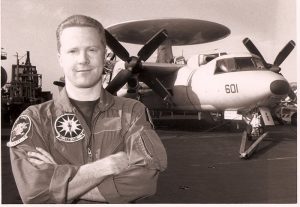
David Alexander, member #1199 and a Cold War era US Navy flyer and air combat veteran of Desert Storm, was trained in and practiced deterring Soviet aggression against the western allies using the typical weapons of the era – nuclear weapons.
But because his type of aircraft carrier-based plane didn’t carry any of these potent bombs itself (instead only helping his teammates who did carry them to be able to penetrate into enemy airspace using electronic countermeasures, etc), he is able to discuss the matter somewhat more freely than they ever could.
After being almost forgotten after the Wall came down in the 1990s, concerns about possible nuclear conflict have come roaring back into the news since the Russian invasion of Ukraine in 2022 and that aggressor nation’s not-so-veiled threats of same.
Ukraine’s hot war is driving dizzying levels of technical and tactical progress in new forms of conventional (i.e., non-nuclear) aerial combat such as satellite-controlled autonomous wingmen, drone swarms and sci-fi grade hypersonic weapons. Yet after years of being ignored and minimally funded in the West, the basic hardware, tactics and geographic mandates underlying the iron fist of theatre-level nuclear deterrence have remained remarkably little changed since the 1980s.
Putting aside the still highly unlikely nightmare scenarios of WWIII style attacks by superpowers directly on each other’s cities, this discussion will instead address what a present day limited “battlefield” nuclear exchange might look like in today’s world hotspots such as Ukraine or Southwest Asia, and what might that experience be like for those aviators actually asked to be ready and able to fly such a mission ?
This discussion will be completely unclassified and use only publicly available published sources available at your local bookstore and newsstand.